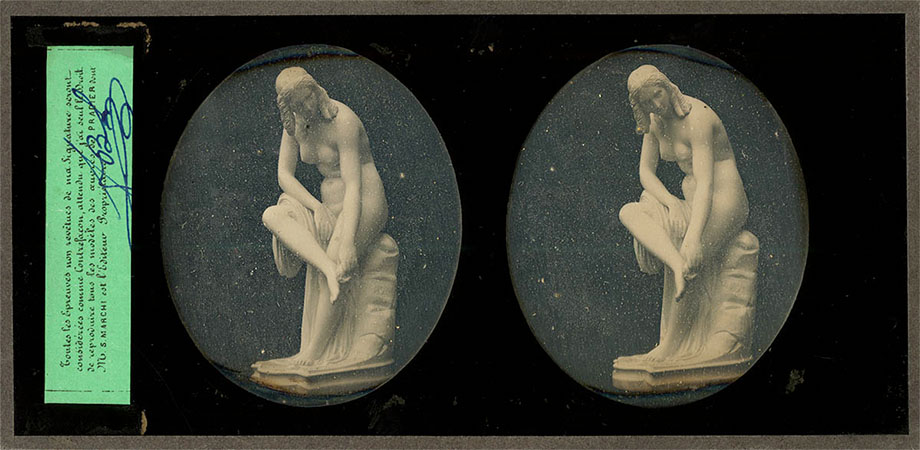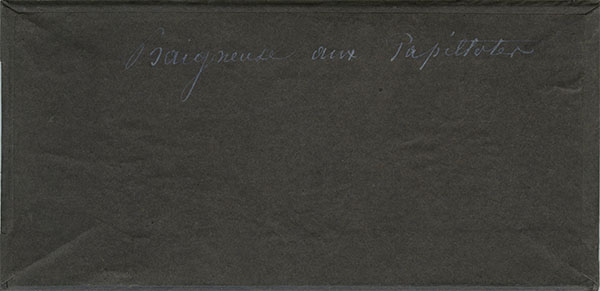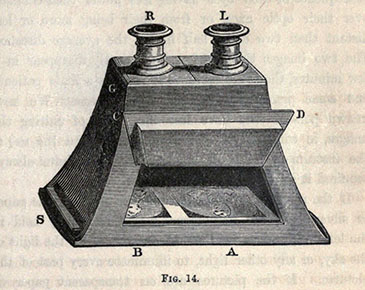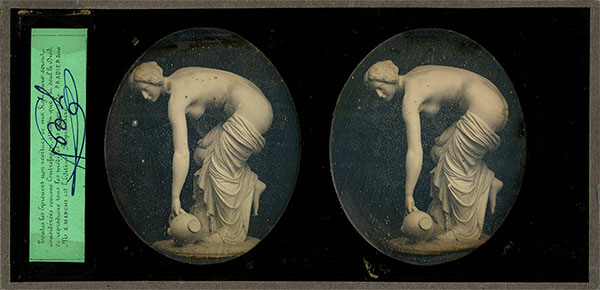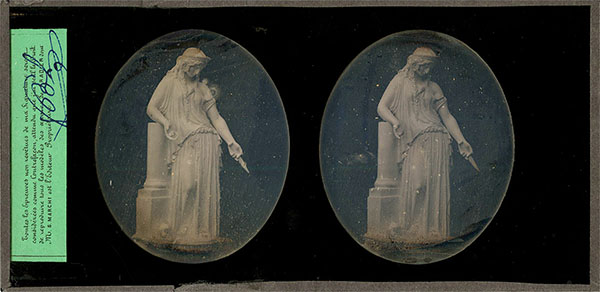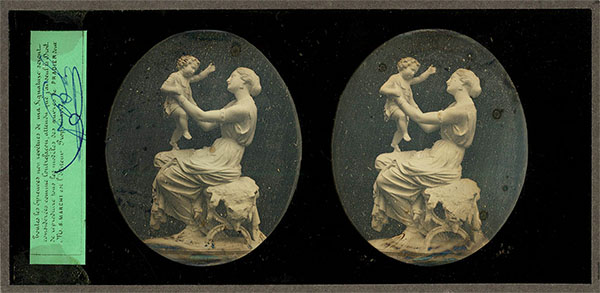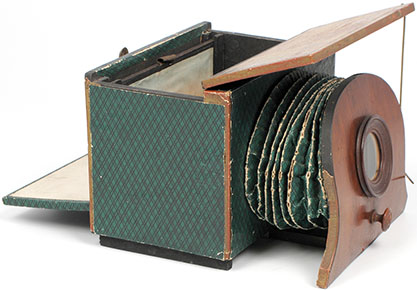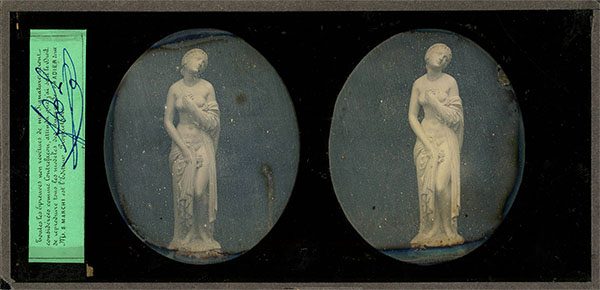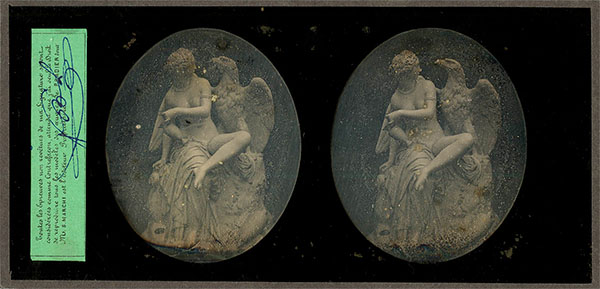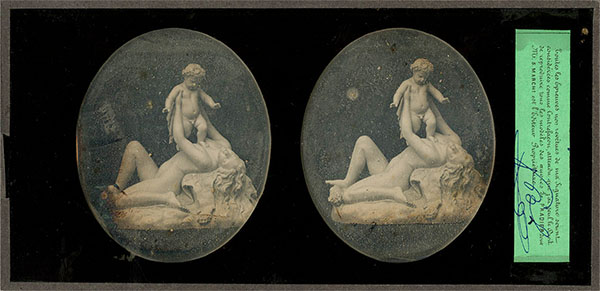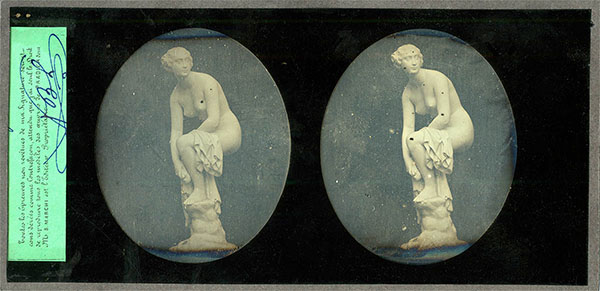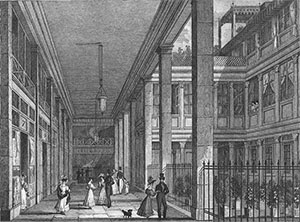This is a scan of a stereo daguerreotype of James Pradier’s statue Baigneuse aux Papilleten (sp?) taken by Lemiare, ca.1852–1855.1 The stereo mount consisted of two trimmed 1/6th plate stereo daguerrotypes, a soda-fluxed glass plate with reverse lampblack painting (a passepartout), a cardboard sink mat, a backing mat and backing paper held together with binding tape around the edges.
Here is the backing paper of the above image:
And here is a sadly broken example showing the overall construction:
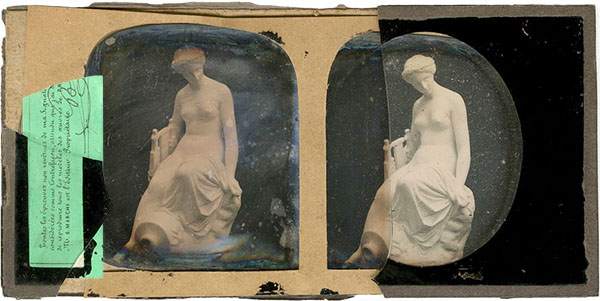
Courtesy Ken Smith, Essex, UK
The idea of binocular vision and stereoscopy were well known long before the invention of photography. Euclid recognized depth perception around 280 AD, Leonardo developed ideas based on perspective in the 1500s and Sir Charles Wheatstone described the first stereoscope in June 1838.2 Ludwig Moser from Königsberg, Germany, later described a method to produce stereoscopic daguerrotypes and on 26 March 1849 Sir David Brewster revealed his “description of several new and simple stereoscopes for exhibiting, as solids, one or more representations of them on a plane” to the Royal Scottish Society of Arts and his lenticular stereoscope became commercially available the next year: 3
From ref. 3
Brewster found little interest in his stereoscope until Jules Duboscq’s work was shown at the Crystal Palace Exhibition in 1851. Queen Victoria was so impressed that she immediately ordered a stereoscope and its popularity took off. Soon English daguerreians, including Claudet, Thompson, Mayer and Peterson began churning out stereo images.
La Danaide
Meevée
La Bonne Mere
French photographers were quick to notice the potential of the stereo image, not only for portraiture, but for documenting science, art and, of course, pornography.
Lemaire, an Opticien Fabricant, 32 Passage du Saumon, Paris,4 had some previous experience with optical novelties. In addition to his typical trade of spectacles and opera glasses, he invented the Polyorama Panoptique – a toy-like viewer of laminated lithographic cards that would change with the lighting:
After the Crystal Palace Exhibition he began to photograph (or supervise the photography of) a series of daguerreotype stereo images of James Pradier’s statues. The stereo plates were marketed (edited) by S. Marchi and included a distinctive and beautifully lettered copyright notice:
“All photographs not covered with my signature are
considered as counterfeit, whereas only I have the right
to reproduce all models of artworks of PRADIER
Mr. S. MARCHI is editor, owner”
Lemiare photographed each of the statues in some commercial, albeit unknown quantity. However, being a daguerrotype, each plate is a single, unique image.
Flore
Medeé et Jupiter
Le por Para de Beacue
La Grande Baigneuse
After the invention of the much simpler wet collodion process in 1851 the daguerrotype began to fade and was virtually all but abandoned by 1860. Stereo views, however, using whatever photographic (or video) process currently in vogue, have continued to be popular to this day.
1. Unfortunately the optics involved in scanning what is essentially a mirror causes every speck of dust and piece of dirt to be reflected in parallax. Trust me, in real life these images appear only half as dusty and dirty.
2. Wheatstone, Charles. Contributions to the Physiology of Vision.—Part the First. On some remarkable, and hitherto unobserved, Phenomena of Binocular Vision. Philosophical Transactions of the Royal Society of London 1838 (128): 371-394 (online). Wheatstone is also remembered as the inventor of the concertina.
3. See: Brewster, David. The Stereoscope. Its History, Theory and Construction.. London: John Murray, 1859 (online). Brewster, a child prodigy, enrolled in the University of Edinburgh at age 12. Although he studied theology, upon graduation he devoted his life to the study of science, particularly optics. He is perhaps best known for discovering the kaleidoscope around 1816. See: Brewster, David. The Kaleidoscope. Its History, Theory and Construction. London: John Murray, 1851 (online).
4. The Passage du Saumon was constructed in 1763 as a path between rue Montorgueil and rue Montmartre (today rue Bauchaumont and rue Léopold-Bellan in the 2nd arrondissement). By the 19th century it became a gallery of trendy shops – including Lemiare’s optical shop – and was something of a fashion mecca until the Second Empire. The passage was purchased in 1853 by the Tunisian general Mahmoud Ben Aïad and was closed by his son in 1899. Here is an 1840 lithograph:
19 Dec 2008, updated 1 Dec 2014 ‧ Photography
Programming note: A significant amount of the photographic material on this site (including this post) were scans from my Dad’s 40-year+ photography collection. Many of the historical details we even researched together.
My Dad died last Monday – he had just turned 84. So as a tribute to my Dad and his lifelong hobby the month of December (and maybe January) will be all photography posts, beginning with this one.
